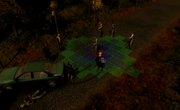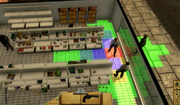
Movement on the combat map is realtime until you elect to enter combat (if there's no one around, but you want to be extra careful), or you or a member of your group are suddenly in the presence of an enemy.
The combat map uses a grid.
Most attacks are in four directions except for the zombies, they do have an attack from a diagonal square.
Maps sizes can vary, but all combat areas are kept on the smaller side (compared to the Shelter) to make exploration and combat manageable. This means you may have a map that includes like a main street and some shops (and alleys and parking lots) but you're not going to be exploring the whole town. Size of areas ranges from large interior areas like a hospital, to tiny maps with an interstate gas station or an overturned truck on a part of the road.
To travel, you do need to have your party at the exit area of a map (there could be several areas on a combat map). There will be an option to leave people behind if they're not at the exit. If they die, they are no longer considered to be in the party.

There are multistory buildings but there are no buildings that are dozens of stories high
Area noise is derived from every single thing making noise in the area.
If you make a lot of noise, about 2-3 zombies will show up at the map entrances per turn assuming you are making the greatest amount of noise possible. If you reach the limit on the map, those zombies are queued up to spawn in as soon as other zombies are killed.
Noise is a local factor. If you leave the map, it's no longer an issue.
Abandoned cars will be searchable
